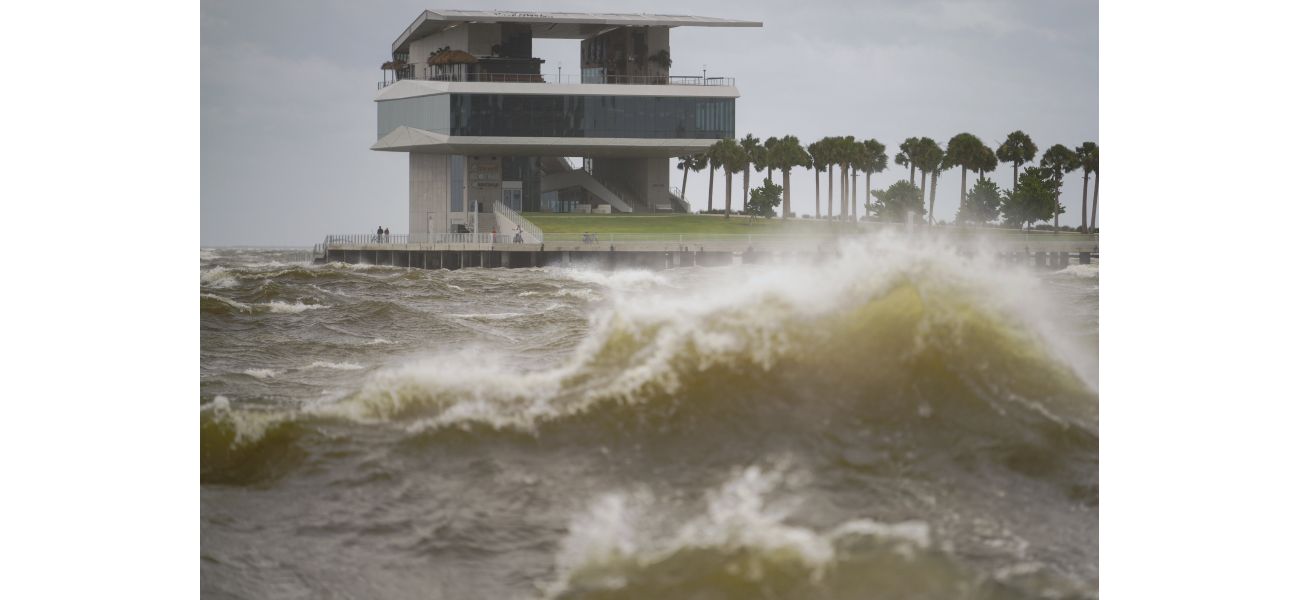Hurricane Helene hits northwestern Florida as a Category 4 storm.
Strong winds in multiple states are causing power outages for over 250,000 properties, prompting emergency declarations.
September 27th 2024.

Hurricane Helene, a fast-moving and dangerous Category 4 storm, has made landfall in the Big Bend area of Florida's northwestern coast. Forecasters are warning of potential catastrophic storm surges, strong winds, heavy rain, and flash floods across a large portion of the southeastern US.
As Helene approached land, it caused extensive damage and power outages in Florida and Georgia. Sadly, there have been reports of fatalities as well. In south Georgia, two people were killed in a possible tornado, and in Florida, one person lost their life while driving on Interstate 4 when a sign fell onto their car.
The storm has caused so much destruction that states of emergency have been declared in Florida, Georgia, the Carolinas, Virginia, and Alabama. The situation is dire, and everyone is being urged to stay safe and seek shelter.
Meanwhile, in the Pacific, former Hurricane John has strengthened back into a hurricane as it threatens parts of Mexico's western coast with flash flooding and mudslides. However, it has now been downgraded to a tropical storm as it moves along the coast of the state of Michoacan.
In the Atlantic, Tropical Storm Isaac has formed and is expected to become a hurricane as it moves away from the US. Forecasters are closely monitoring its progress and urging people to stay informed and prepared.
In Florida, Governor Ron DeSantis has reported one fatality and warned that there may be more as the storm progresses. He also stated that thousands of National Guardsmen are ready to assist with the response efforts. The governor stressed the danger of the conditions and urged people to remain indoors and keep those affected in their thoughts and prayers.
Helene made landfall near Perry, Florida, around 11:10 p.m. EDT with maximum sustained winds of 140 mph. The National Hurricane Center has warned of storm surges up to 20 feet, which could be catastrophic and unsurvivable in some areas, particularly in Apalachee Bay.
The effects of the storm extend far beyond the coast, with hurricane and flash flood warnings reaching into northern Georgia and western North Carolina.
As of 11 p.m. EDT, over 885,000 customers in Florida were without power, according to poweroutage.us. The majority of these outages are in the Big Bend area, where Helene made landfall.
In the Pacific, former Hurricane John has caused significant damage and is still a threat as a tropical storm. Its slow movement along the coast has led to severe flash flooding, and the National Hurricane Center is closely monitoring its progress.
John initially hit Mexico as a Category 3 hurricane, causing destruction and loss of life. After weakening and reemerging over the ocean, it has now re-strengthened into a hurricane and is expected to weaken again as it moves along the coast.
The devastation caused by these hurricanes is a reminder of the power and danger of these storms. Authorities are urging everyone to follow safety precautions and stay informed about the progress of these storms.
The people of Florida and the southeastern US were on high alert as Hurricane Helene rapidly approached the coast. According to forecasters, the powerful storm was classified as a Category 4 and was expected to cause severe damage with its strong winds, heavy rains, and flash floods. As the storm made landfall in the Big Bend area of Florida's northwestern coast on Thursday evening, authorities issued warnings of a potentially "catastrophic" storm surge that could affect areas hundreds of miles inland.
As the storm approached, reports came in from Georgia of two fatalities due to a possible tornado. Sadly, there was also a tragic incident in Florida where a person lost their life while driving on Interstate 4 when a sign fell onto their car. Florida Governor Ron DeSantis expressed his condolences and urged people to take caution and stay safe. The storm caused widespread power outages, affecting over 1 million homes and businesses in Florida and over 50,000 in Georgia.
Several states, including Florida, Georgia, the Carolinas, Virginia, and Alabama, declared a state of emergency in preparation for the storm. In the Pacific, former Hurricane John regained its strength on Thursday morning and posed a threat to areas of Mexico's western coast with the risk of flash flooding and mudslides. Meanwhile, Tropical Storm Isaac formed in the Atlantic Ocean and was predicted to intensify as it moved away from the US, possibly becoming a hurricane by the end of the week.
Governor DeSantis shared the unfortunate news of another reported fatality due to the storm's impact. He emphasized the dangerous conditions and urged people to stay indoors and remain vigilant. The governor also warned that there could be more casualties and damage as the storm continued its path. He announced that 3,500 National Guardsmen were ready to assist with the response efforts.
Hurricane Helene made landfall on Thursday night in northwestern Florida, bringing with it maximum sustained winds of 140 mph. The National Hurricane Centre in Miami reported that the storm came ashore near Perry, Florida, in the Big Bend area. The forecast also warned of possible storm surges up to 20 feet, which could be particularly devastating in Apalachee Bay. As the storm moved further inland, hurricane warnings and flash flood warnings were issued for areas beyond the coast, including northern Georgia and western North Carolina.
As the night progressed, the number of power outages continued to rise, with over 885,000 customers without electricity at 11 p.m. EDT. Most affected were counties in the Big Bend area, where the storm was expected to make landfall. In the Pacific, former Hurricane John was downgraded to a tropical storm on Thursday evening. However, it still posed a threat to coastal areas in Mexico with its sustained wind speeds of 70 mph. The storm had initially hit Mexico earlier in the week, causing significant damage and then reemerging over the ocean.
The US National Hurricane Centre reported that John was expected to weaken as it moved along the coast of the Mexican state of Michoacan. However, there was still a risk of severe flash flooding. The storm's strength had fluctuated throughout the week, initially making landfall as a Category 3 hurricane in Acapulco and then weakening before regaining intensity and becoming a hurricane again on Thursday. The forecast predicted that the storm would continue to weaken as it moved further inland.
As Helene approached land, it caused extensive damage and power outages in Florida and Georgia. Sadly, there have been reports of fatalities as well. In south Georgia, two people were killed in a possible tornado, and in Florida, one person lost their life while driving on Interstate 4 when a sign fell onto their car.
The storm has caused so much destruction that states of emergency have been declared in Florida, Georgia, the Carolinas, Virginia, and Alabama. The situation is dire, and everyone is being urged to stay safe and seek shelter.
Meanwhile, in the Pacific, former Hurricane John has strengthened back into a hurricane as it threatens parts of Mexico's western coast with flash flooding and mudslides. However, it has now been downgraded to a tropical storm as it moves along the coast of the state of Michoacan.
In the Atlantic, Tropical Storm Isaac has formed and is expected to become a hurricane as it moves away from the US. Forecasters are closely monitoring its progress and urging people to stay informed and prepared.
In Florida, Governor Ron DeSantis has reported one fatality and warned that there may be more as the storm progresses. He also stated that thousands of National Guardsmen are ready to assist with the response efforts. The governor stressed the danger of the conditions and urged people to remain indoors and keep those affected in their thoughts and prayers.
Helene made landfall near Perry, Florida, around 11:10 p.m. EDT with maximum sustained winds of 140 mph. The National Hurricane Center has warned of storm surges up to 20 feet, which could be catastrophic and unsurvivable in some areas, particularly in Apalachee Bay.
The effects of the storm extend far beyond the coast, with hurricane and flash flood warnings reaching into northern Georgia and western North Carolina.
As of 11 p.m. EDT, over 885,000 customers in Florida were without power, according to poweroutage.us. The majority of these outages are in the Big Bend area, where Helene made landfall.
In the Pacific, former Hurricane John has caused significant damage and is still a threat as a tropical storm. Its slow movement along the coast has led to severe flash flooding, and the National Hurricane Center is closely monitoring its progress.
John initially hit Mexico as a Category 3 hurricane, causing destruction and loss of life. After weakening and reemerging over the ocean, it has now re-strengthened into a hurricane and is expected to weaken again as it moves along the coast.
The devastation caused by these hurricanes is a reminder of the power and danger of these storms. Authorities are urging everyone to follow safety precautions and stay informed about the progress of these storms.
The people of Florida and the southeastern US were on high alert as Hurricane Helene rapidly approached the coast. According to forecasters, the powerful storm was classified as a Category 4 and was expected to cause severe damage with its strong winds, heavy rains, and flash floods. As the storm made landfall in the Big Bend area of Florida's northwestern coast on Thursday evening, authorities issued warnings of a potentially "catastrophic" storm surge that could affect areas hundreds of miles inland.
As the storm approached, reports came in from Georgia of two fatalities due to a possible tornado. Sadly, there was also a tragic incident in Florida where a person lost their life while driving on Interstate 4 when a sign fell onto their car. Florida Governor Ron DeSantis expressed his condolences and urged people to take caution and stay safe. The storm caused widespread power outages, affecting over 1 million homes and businesses in Florida and over 50,000 in Georgia.
Several states, including Florida, Georgia, the Carolinas, Virginia, and Alabama, declared a state of emergency in preparation for the storm. In the Pacific, former Hurricane John regained its strength on Thursday morning and posed a threat to areas of Mexico's western coast with the risk of flash flooding and mudslides. Meanwhile, Tropical Storm Isaac formed in the Atlantic Ocean and was predicted to intensify as it moved away from the US, possibly becoming a hurricane by the end of the week.
Governor DeSantis shared the unfortunate news of another reported fatality due to the storm's impact. He emphasized the dangerous conditions and urged people to stay indoors and remain vigilant. The governor also warned that there could be more casualties and damage as the storm continued its path. He announced that 3,500 National Guardsmen were ready to assist with the response efforts.
Hurricane Helene made landfall on Thursday night in northwestern Florida, bringing with it maximum sustained winds of 140 mph. The National Hurricane Centre in Miami reported that the storm came ashore near Perry, Florida, in the Big Bend area. The forecast also warned of possible storm surges up to 20 feet, which could be particularly devastating in Apalachee Bay. As the storm moved further inland, hurricane warnings and flash flood warnings were issued for areas beyond the coast, including northern Georgia and western North Carolina.
As the night progressed, the number of power outages continued to rise, with over 885,000 customers without electricity at 11 p.m. EDT. Most affected were counties in the Big Bend area, where the storm was expected to make landfall. In the Pacific, former Hurricane John was downgraded to a tropical storm on Thursday evening. However, it still posed a threat to coastal areas in Mexico with its sustained wind speeds of 70 mph. The storm had initially hit Mexico earlier in the week, causing significant damage and then reemerging over the ocean.
The US National Hurricane Centre reported that John was expected to weaken as it moved along the coast of the Mexican state of Michoacan. However, there was still a risk of severe flash flooding. The storm's strength had fluctuated throughout the week, initially making landfall as a Category 3 hurricane in Acapulco and then weakening before regaining intensity and becoming a hurricane again on Thursday. The forecast predicted that the storm would continue to weaken as it moved further inland.
[This article has been trending online recently and has been generated with AI. Your feed is customized.]
[Generative AI is experimental.]
0
0
Submit Comment





